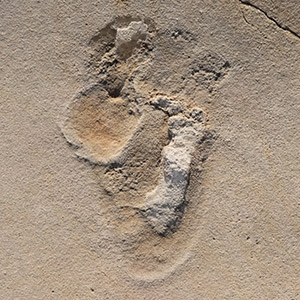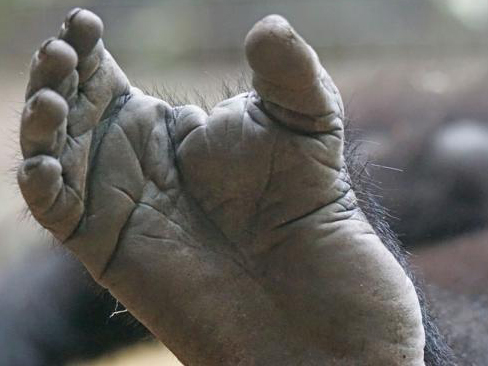Has Human Evolution Tripped Us Up?
5.7 Million-year-old Hominin Footprints on Crete
The chance discovery of hominin fossilised footprints on the Mediterranean island of Crete, has challenged the accepted theory of human evolution. The footprints, which have been dated to around 5.7 million years ago, were formed when all other hominins known to science were restricted to Africa and they had much more ape-like feet. If the series of tracks prove to be accurately dated, then this challenges the idea that hominins (those species more closely related to us than they are to a chimpanzee), evolved in Africa. Has someone just rocked the “cradle of humanity”?
A Photograph of the Tracks (Ancient Hominin Footprints)
Picture credit: Andrzej Boczarowski
The Out of Africa Theory
With the discovery of the Laetoli footprints in Tanzania in the mid 1970s (believed to have been made by a small group of Australopithecus afarensis), which were formed some 3.7 million years ago, our species (H. sapiens) and our direct ancestors were thought to have originated in Africa. These footprints, show very human-like feet with a distinctive shape, a big toe and a human gait.
The gait of these early humans was “heel-strike” (the heel of the foot hits first) followed by “toe-off” (the toes push off at the end of the stride), the same way that modern humans walk. Early hominins were thought to have remained isolated in Africa before dispersing to Europe and Asia, hundreds of thousands of years after they first evolved.
The discovery of approximately 5.7 million-year-old human-like footprints from Crete, published online this week by an international team of researchers, including scientists from Uppsala University (Sweden), overturns this rather simple picture and suggests a more complicated evolutionary path for our ancestors.
A Close View of One of the Footprints (right foot)

A fossilised hominin footprint from Trachilos (western Crete). The right footprint is estimated to be 5.7 million years old.
Picture credit: Andrzej Boczarowski
The picture above shows a close-up of one of the footprints, the big toe can be clearly seen. Our feet have a very distinctive shape. We have five short toes without claws, the hallux (big toe), is much larger than the other toes and our foot has a long sole. The feet of the great apes, are very different. They resemble a human hand with a thumb-like hallux that sticks out to the side. The Laetoli footprints, ascribed to A. afarensis, are quite similar to those of modern humans except that the heel is narrower and the sole lacks a proper arch.
The 4.4 million-year-old Ardipithecus ramidus from Ethiopia, the oldest hominin known from reasonably complete fossils, has an ape-like foot. The researchers who described Ardipithecus argued that it is a direct ancestor of later hominins, implying that a human-like foot evolved later.
The Trachilos Tracks
The newly described tracks from Trachilos in western Crete bear a close resemblance to a human footprint. The big toe has similar morphology and there seems to be a distinct “ball” on the sole, which is absent in primates. The sole of the foot is proportionately shorter than in the Laetoli prints, but it has the same general form. The prints do look as if they were made by a hominin.
The Foot of a Great Ape (Note the Position of the Big Toe)
Approximately fifty tracks were made when bipeds walked across a sandy area and although many large apes are known from the Late Miocene of Europe, no hominin was thought to have migrated into Europe for millions of years after the tracks were made.
Professor Per Ahlberg (Uppsala University), the lead author of the study commented:
“What makes this controversial is the age and location of the prints.”
At approximately 5.7 million years, they are younger than the oldest known fossil hominin, Sahelanthropus from Chad, and contemporary with Orrorin (O. tugenensis), from Kenya, but more than a million years older than Ardipithecus ramidus with its ape-like feet.
This fossil find throws into question the hypothesis that Ardipithecus is a direct ancestor of later hominins. In addition, until this year, all fossil hominins older than 1.8 million years (the age of early Homo fossils from Georgia), came from Africa, leading most researchers to conclude that this was where the group evolved.
Studying the Hominin Prints
However, the Trachilos footprints are securely dated using a combination of foraminifera (marine micro-fossils) from over and underlying bedding planes, plus the fact that they lie just below a very distinctive sedimentary rock formed when the Mediterranean Sea temporarily evaporated around 5.6 million years ago. Coincidentally, earlier this year, another group of researchers, led by Professor Madelaine Böhme of the University of Tübingen, (Germany), writing in the Journal PLOS One, reinterpreted the fragmentary 7.2 million-year-old primate Graecopithecus freybergi from Greece and Bulgaria as a hominin.
Professor Ahlberg added:
“This discovery challenges the established narrative of early human evolution head-on and is likely to generate a lot of debate. Whether the human origins research community will accept fossil footprints as conclusive evidence of the presence of hominins in the Miocene of Crete remains to be seen.”
The eastern Mediterranean in the Late Miocene consisted of extensive, arid grasslands, the Sahara Desert did not exist and Crete was still part of the Greek mainland. Early hominins could have ranged along this habitat moving from Africa to south-eastern Europe, with one group leaving their footprints on the shores of the Mediterranean that would one-day form part of the island of Crete.
The scientific paper: “Possible Hominin Footprints from the Late Miocene (c. 5.7 Ma) of Crete?” Gierlinski, G. D. et al. 2017. published in the Proceedings of the Geologists’ Association.
Everything Dinosaur acknowledges the help of an Uppsala University press release in the compilation of this article.
Visit the Everything Dinosaur website: Everything Dinosaur.



